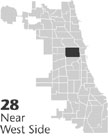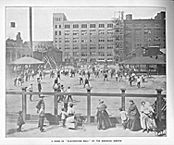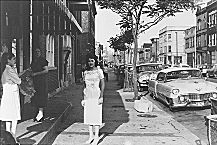| Entries |
| N |
|
Near West Side
|
 The Near West Side Community Area 28, 2 miles W of the Loop. is bounded by the Chicago & Northwestern
Railroad
to the north, the Pennsylvania Railroad to the west, the South Branch of the
Chicago River
to the east, and 16th Street at its southern edge. Between the 1840s and the early 1860s, the district was easily accessible from the Lake Street business district. At a convenient distance from the business center, the wealthy residents of Union Park sought to make the West Side an elite refuge from the daily commotion of the growing city. They created Jefferson Park (1850) and Union Park (1854) as small, safe public resorts.
The Near West Side Community Area 28, 2 miles W of the Loop. is bounded by the Chicago & Northwestern
Railroad
to the north, the Pennsylvania Railroad to the west, the South Branch of the
Chicago River
to the east, and 16th Street at its southern edge. Between the 1840s and the early 1860s, the district was easily accessible from the Lake Street business district. At a convenient distance from the business center, the wealthy residents of Union Park sought to make the West Side an elite refuge from the daily commotion of the growing city. They created Jefferson Park (1850) and Union Park (1854) as small, safe public resorts.

|
Wholesale trade businesses and manufacturers located on the north along an east-west axis in the 1870s and the 1880s. Lined with three and four-story buildings, many of which housed several business establishments, the area provided a dense center of employment opportunity.
In the middle of this rapidly changing area in 1889, Jane Addams and Ellen Gates Starr opened Hull House, one of the few institutions inclined to combine a policy of Americanization with celebration of the neighborhood's ethnic diversity. African Americans were less welcome, relegated instead to the less comprehensive institutions that catered only to blacks.
Most institution building on the Near West Side emerged out of the efforts of individual ethnic groups to reconstruct cultural worlds left behind in Europe. The struggles among ethnic groups over urban space materialized in the construction and relocation of religious and educational institutions, along with the succession of saloons and small businesses. These tensions, sometimes marked by violence, along with economic mobility, led to an ongoing process of neighborhood succession, as older groups were replaced by newcomers. Those who left sold institutions to groups who stayed behind, or to the newcomers. The home of Sacred Heart Academy (1860), for example, became the site of the Chicago Hebrew Institute (1903).

|
The second half of the twentieth century brought major alterations to the Near West Side. The Chicago Circle expressway interchange wiped out a significant section of “Greek town.” The construction of the University of Illinois at Chicago (UIC), resulted in the demolition of most of the Hull House complex, as well as the historic Italian neighborhood. Neither urban renewal nor the construction of public housing, both of which began before 1950 and continued into the 1960s, could alleviate the poverty that had resulted from continued migration in the face of a declining economic base on the West Side. The riots after Martin Luther King's assassination in 1968 left a physical devastation on the West Side as a whole that reinforced existing images of the area as crime-ridden and bereft of hope.
University expansion toward the end of twentieth century once again reshaped the Near West Side, almost completely destroying the historical Maxwell Street Market and contributing to the gentrification that followed patterns established by other neighborhoods bordering the Loop. With the increase in real-estate values around UIC, and the construction of the new United Center, parts of the Near West Side became increasingly attractive to middle-class and upper-middle-class Chicagoans interested in living near the downtown.
| Near West Side (CA 28) | |||||
| Year |
Total
(and by category) |
Foreign Born | Native with foreign parentage | Males per 100 females | |
| 1930 | 152,457 | 25.1% | 33.4% | 127 | |
| 119,696 | White (78.5%) | ||||
| 25,239 | Negro (16.6%) | ||||
| 7,522 | Other (4.9%) | ||||
| 1960 | 126,610 | 7.5% | 10.5% | 113 | |
| 788 | White (0.6%) | ||||
| 68,146 | Negro (53.8%) | ||||
| 57,676 | Other races (45.6%) | ||||
| 1990 | 46,197 | 9.8% | — | 88 | |
| 10,332 | White (22.4%) | ||||
| 31,052 | Black (67.2%) | ||||
| 109 | American Indian (0.2%) | ||||
| 2,374 | Asian/Pacific Islander (5.1%) | ||||
| 2,321 | Other race (5.0%) | ||||
| 4,416 | Hispanic Origin* (9.6%) | ||||
| 2000 | 46,419 | 12.6% | — | 95 | |
| 13,486 | White alone (29.1%) | ||||
| 24,706 | Black or African American alone (53.2%) | ||||
| 88 | American Indian and Alaska Native alone (0.2%) | ||||
| 4,926 | Asian alone (10.6%) | ||||
| 95 | Native Hawaiian and Other Pacific Islander alone (0.2%) | ||||
| 2,212 | Some other race alone (4.8%) | ||||
| 906 | Two or more races (2.0%) | ||||
| 4,415 | Hispanic or Latino* (9.5%) | ||||
The Encyclopedia of Chicago © 2004 The Newberry Library. All Rights Reserved. Portions are copyrighted by other institutions and individuals. Additional information on copyright and permissions.